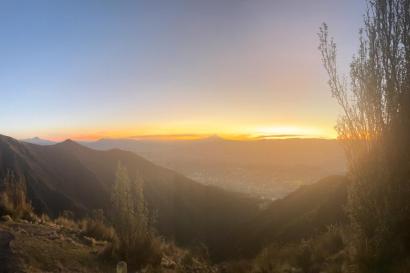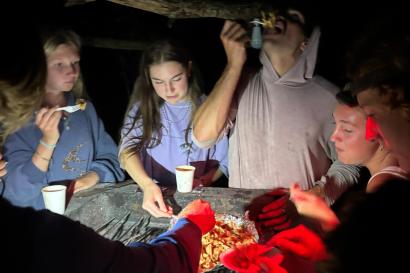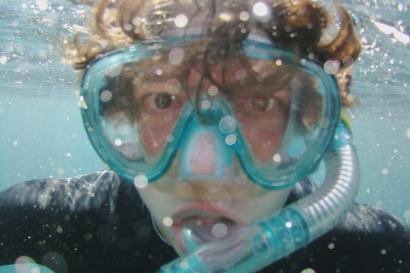As a part of the IES Abroad program, during our spring break, an opportunity for a getaway vacation was graciously given to us. Naturally and thankfully, this just meant traveling from one tropical island to several other tropical islands. Throughout this week, I was able to visit the islands of Floreana, Isabela, and Santa Cruz. It was fascinating to observe the subtle yet distinctive differences between these islands, since that is really what makes them so intriguing to humans in the first place.
Our first destination was a brief stop to Isla Floreana. Here, the ratio of marine iguanas to humans is probably around 30,000,000 to 1, as really only a handful of families live on this island. We first took a chiva up to the highlands to visit the tortoise breeding facilities there. I still can’t truly conceive the fact that these creatures exist, not to mention that they roam freely outside the walls of places like this. They are just so large and clumsy. It’s a miracle that they can even move, but I love them even more for it. Additionally, our guide told us the spooky human history of this island, which includes a German Baroness and her two lovers (and their deaths), a philosopher and the wife he experimented on (and their deaths), a blind boy who was sent on a fishing trip (and his death, of course), and cannibalism (surprisingly, no one died here. I’m just kidding, it was cannibalism). Next, we went snorkeling at Playa Negra, an appropriately named beach due to its black sand. It was simply gorgeous and was lined with palm trees and picturesque volcanic rocks. The sea life was abundant, but the memories were even more abundant (I’m sorry, I’ll never be that cheesy again).
Next, we took a boat to Isabela, the largest island in the archipelago. I knew just from the first minutes that this would be my favorite island due solely to the fact that the bay was overlooked by about ten penguins. Out of all the things I expected to encounter in my life, wild penguins were very low on the list. I mean, I’m literally on the equator. Who put penguins on the equator?? Anyways, during our first full day, we hiked upon Volcán Sierra Negra, the second largest volcanic crater in the world. As an aspiring geologist, I could not hold in my excitement, especially considering that it had erupted just this past year. My friends could even tell how giddy I was to be here. On a similar note, we walked on and snorkeled at the túneles, a collection of lava tubes and formations created from immense volcanic activity. To be standing on top of the things I read about in textbooks in Cleveland will never cease to fascinate me. There were also the largest sea turtles I have ever seen here, munching on algae just feet away from us. Later on, we visited a little nearby islet called Tintoreras. The landscape was like no volcanic rocks I’d ever seen before. They stuck up like a field of miniature jagged cones that reminded me of the final battle scene of Avatar: The Last Airbender (if you know, you know). There were a bunch of baby marine iguanas cuddled up nearby, some no more than eight inches long, compared to the two or three feet of the adults. There was also a sliver of a canal, where young white-tip sharks casually passed back and forth beneath us. We snorkeled close by as well and were able to get absurdly close to sharks, rays, puffer fish, and octopi. The beach near Isabela’s largest town had the best beach I have been to so far. It was fine sand and spread for miles, and it allowed us to view what I can safely guarantee was the most captivating sunset in the history of the world.
We next traveled to Santa Cruz, the island with the largest human population of 20,000 residents or so. It was clearly more touristy than all the other islands combined. While we were here, we were able to visit the Charles Darwin Research Center, where there was a breeding center and museum as well as the stuffed remains of Lonesome George, the poster child (poster tortoise?) for conservation in the Galápagos. Additionally, we spent a day at Tortuga Bay, a serene location with literal piles of iguanas, active brown pelicans, and several baby black-tip sharks swimming right near the edge of the bay. Later, we ventured into Las Grietas, a narrow canyon-like volcanic formation filled with water and plenty of large fish, which confused us because it was nowhere near the ocean. I climbed probably way too high up the sharp walls to jump all the way down into the water, and I definitely didn’t cut myself a little bit.
I was going to say that this spring break was essential to help me relieve stress and prepare for the end of the semester, but then I remembered that I’m lucky enough to live in the freaking Galápagos Islands. Stress as a concept doesn’t necessarily exist here. Also, I don’t think I can ever be prepared to leave. After visiting three more of the other islands, my biggest takeaway is that the finches appeared slightly different from each other on each island. I wonder if anyone else has noticed that. I’m going to assume not and write a paper about it and maybe come up with a theory or two.

Thomas Hotaling
<p class="MsoBodyText" style="margin-top:.4pt; margin-right:21.05pt; margin-bottom:.0001pt; margin-left:5.5pt"><span style="line-height:103%">Hello! My name is Thomas, and I’m from St. Louis, Missouri and currently am a second year at Case Western Reserve University. I like to think of myself as an avid outdoorsman, and you can often find me backpacking or just having fun outside, and I’m even a summer camp nature counselor. I'm currently studying environmental geology because rocks are the absolute coolest, and if you don't believe me I'd be happy to share my opinions with you.</span></p>








